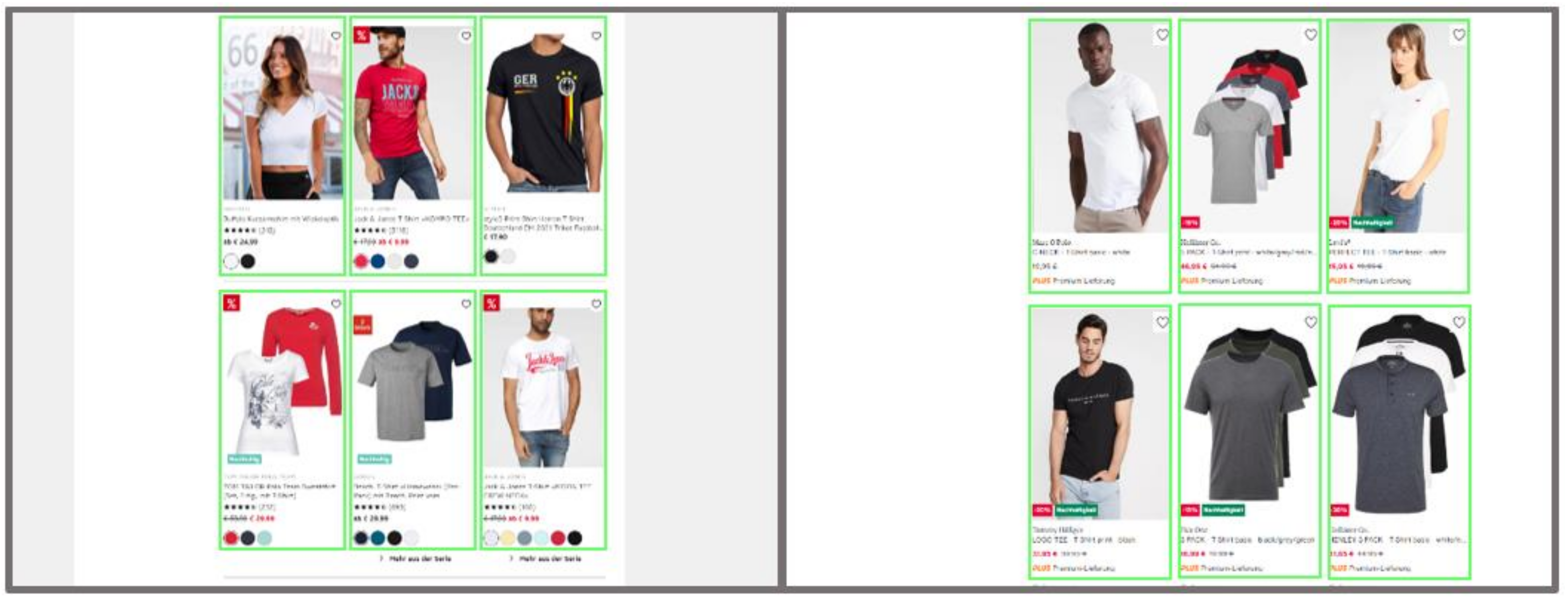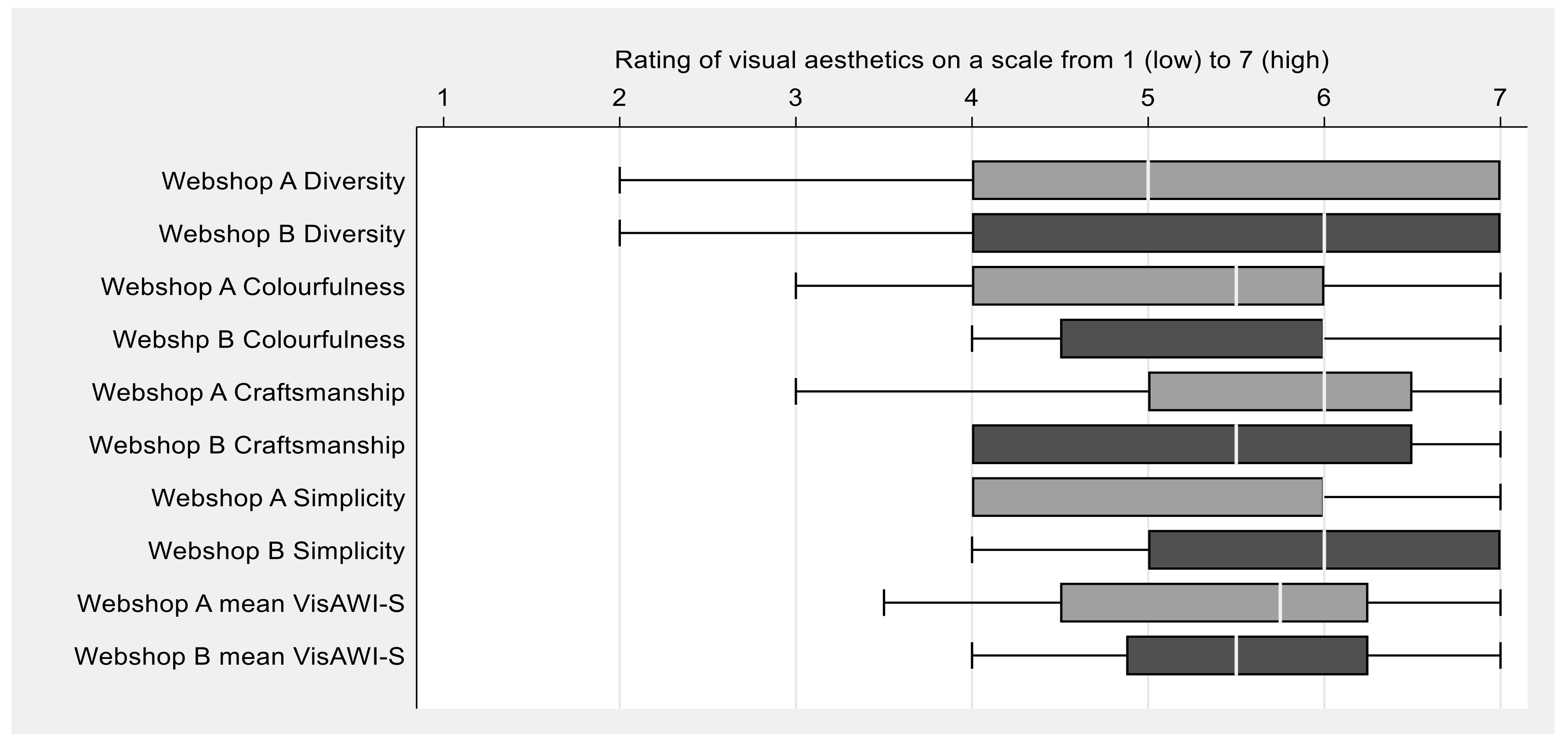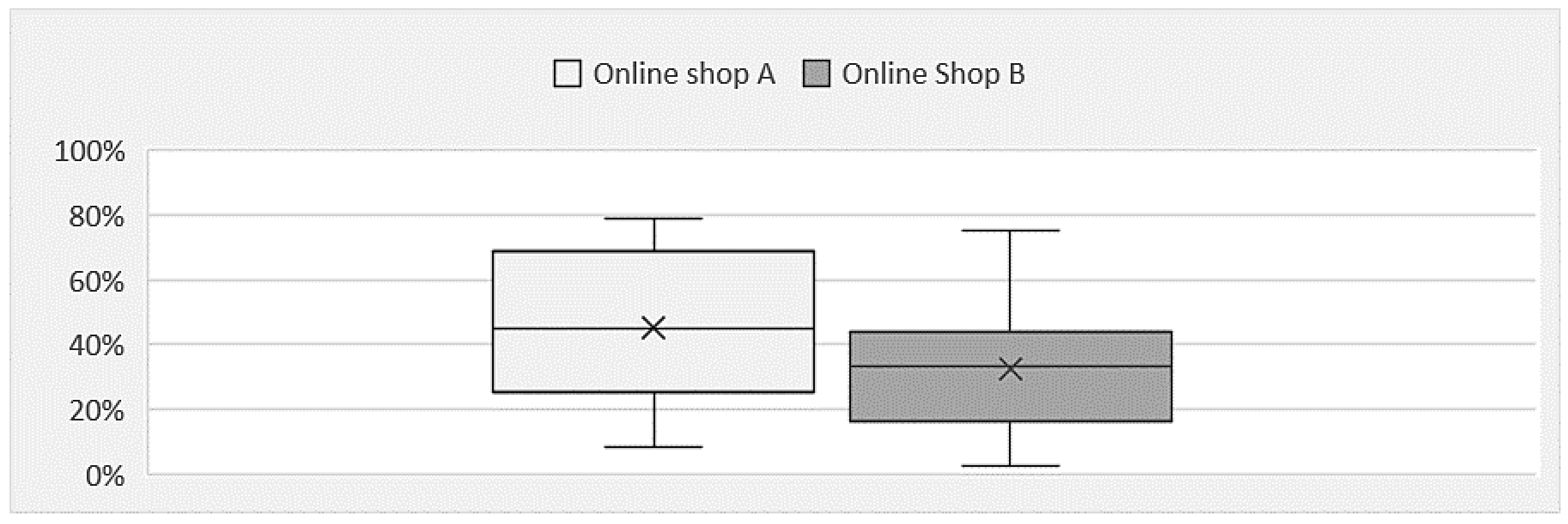Webcam Eye Tracking for Monitoring Visual Attention in Hypothetical Online Shopping Tasks
Abstract
:1. Introduction
- Horizontal position of the product on the online shop’s website;
- Vertical position of the product on the online shop’s website;
- Product picture displaying the clothes worn by a person vs. product picture displaying only the clothes.
2. Literature Review
3. Materials and Methods
3.1. Participants
3.2. Software and Hardware
3.3. Stimuli and Task
3.4. Data Analysis
4. Results
4.1. Eye Tracking Quota
4.2. Assessment of the Online Shops’ Visual Aesthetics
4.3. Visual Attention Paid to the Product Depictions
5. Discussion
Limitations and Further Research
6. Conclusions
Author Contributions
Funding
Institutional Review Board Statement
Informed Consent Statement
Data Availability Statement
Conflicts of Interest
References
- Statista. E-Commerce in Europa: Dossier; did-23510-1. Available online: https://de.statista.com/statistik/studie/id/23510/dokument/e-commerce-in-europa-statista-dossier/ (accessed on 4 October 2021).
- Bauerová, R. Online grocery shopping is a privilege of millennial customers. Still truth in COVID-19 pandemic? Acta Acad. Karviniensia 2021, 21, 15–28. [Google Scholar] [CrossRef]
- Riz, N.; Partacini, L.; Becker, U.; Lun, G.; Dibiasi, A.; Pechlaner, H. Die Effekte der COVID-19-Pandemie in Südtirol. Die Sicht Südtiroler Unternehmen: WIFO Bericht. 2020. Available online: https://webassets.eurac.edu/31538/1622811251-die-effekte-der-covid-19-pandemie-in-sudtirol-die-sicht-der-sudtiroler-unternehmen.pdf (accessed on 22 July 2021).
- Rudolph, T.; Kralle, N. Detailhändler investieren in Onlineshops. Die Volkswirtschaft 2020, 93, 12–14. [Google Scholar]
- Behe, B.K.; Bae, M.; Huddleston, P.; Sage, L. The effect of involvement on visual attention and product choice. J. Retail. Consum. Serv. 2015, 24, 10–21. [Google Scholar] [CrossRef]
- Atalay, A.S.; Bodur, H.O.; Rasolofoarison, D. Center of shelf attention: Understanding the role of visual attention on product choice. N. Am. Adv. Consum. Res. 2012, 40, 809–810. [Google Scholar]
- Gidlöf, K.; Anikin, A.; Lingonblad, M.; Wallin, A. Looking is buying. How visual attention and choice are affected by consumer preferences and properties of the supermarket shelf. Appetite 2017, 116, 29–38. [Google Scholar] [CrossRef]
- Burton, L.; Albert, W.; Flynn, M. A Comparison of the Performance of Webcam vs. Infrared Eye Tracking Technology. In Proceedings of the Human Factors and Ergonomics Society Annual Meeting, Los Angeles, CA, USA, 4 November 2014; Volume 58, pp. 1437–1441. [Google Scholar] [CrossRef]
- Semmelmann, K.; Weigelt, S. Online webcam-based eye tracking in cognitive science: A first look. Behav. Res. Methods 2018, 50, 451–465. [Google Scholar] [CrossRef] [PubMed] [Green Version]
- Statista Research Department. E-Commerce in Deutschland: Daten und Fakten zum boomenden Onlinegeschäft. Available online: https://de.statista.com/themen/247/e-commerce/ (accessed on 27 August 2021).
- Zdziebko, T.; Sulikowski, P. Monitoring human website interactions for online stores. In New Contributions in Information Systems and Technologies; Rocha, A., Correia, A.M., Costanzo, S., Reis, L.P., Eds.; Springer International Publishing: Cham, Switzerland, 2015. [Google Scholar]
- Sulikowski, P.; Zdziebko, T. Horizontal vs. Vertical Recommendation Zones Evaluation Using Behavior Tracking. Appl. Sci. 2020, 11, 56. [Google Scholar] [CrossRef]
- Sulikowski, P.; Zdziebko, T.; Coussement, K.; Dyczkowski, K.; Kluza, K.; Sachpazidu-Wójcicka, K. Gaze and Event Tracking for Evaluation of Recommendation-Driven Purchase. Sensors 2021, 21, 1381. [Google Scholar] [CrossRef] [PubMed]
- Wedel, M.; Pieters, R. A review of eye-tracking research in marketing. In Review of Marketing Research, 4th ed.; Malhotra, N.K., Ed.; Sharpe Inc.: New York, NY, USA, 2008; pp. 123–147. ISBN 978-0-7656-2092-7. [Google Scholar]
- Cardoso, T.V.; Michelassi, G.C.; Franco, F.O.; Sumiya, F.M.; Portolese, J.; Brentani, H.; Machado-Lima, A.; Nunes, F.L.S. Autism Spectrum Disorder diagnosis based on trajectories of eye tracking data. In Proceedings of the 2021 IEEE 34th International Symposium on Computer-Based Medical Systems (CBMS), Aveiro, Portugal, 7–9 June 2021; pp. 50–55. [Google Scholar] [CrossRef]
- Tatler, B.W.; Kirtley, C.; Macdonald, R.G.; Mitchell, K.M.; Savage, S.W. The active eye: Perspectives on eye movement research. In Current Trends in Eye Tracking Research; Horsley, M., Eliot, M., Knight, B.A., Reilly, R., Eds.; Springer International Publishing: Cham, Switzerland, 2014; pp. 3–16. [Google Scholar]
- Knight, B.A.; Horsley, M.; Eliot, M. Eye Tracking and the Learning System: An Overview. In Current Trends in Eye Tracking Research; Springer: Cham, Switzerland, 2014; pp. 281–285. [Google Scholar]
- Tobii Pro AB. Pro Nano User Manual: Version 2.0. 2020. Available online: https://www.tobiipro.com/siteassets/tobii-pro/user-manuals/tobii-pro-nano-user-manual.pdf/?v=2.0 (accessed on 28 July 2021).
- Krassanakis, V.; Cybulski, P. Eye Tracking Research in Cartography: Looking into the Future. ISPRS Int. J. Geo-Inf. 2021, 10, 411. [Google Scholar] [CrossRef]
- Papoutsaki, A.; Laskey, J.; Huang, J. SearchGazer: Webcam eye tracking for remote studies of web search. In Proceedings of the 2017 Conference on Conference Human Information Interaction and Retrieval. CHIIR ’17: Conference on Human Information Interaction and Retrieval, Oslo, Norway, 7–11 March 2017; Nordlie, R., Pharo, N., Freund, L., Larsen, B., Russel, D., Eds.; ACM: New York, NY, USA, 2017; pp. 17–26, ISBN 9781450346771. [Google Scholar]
- Geise, S. Eyetracking in der Kommunikations- und Medienwissenschaft: Theorie, Methode und kritische Reflexion. Stud. Commun. Media 2011, 2, 149–263. [Google Scholar] [CrossRef] [Green Version]
- Orquin, J.L.; Bagger, M.P.; Lahm, E.S.; Grunert, K.G.; Scholderer, J. The visual ecology of product packaging and its effects on consumer attention. J. Bus. Res. 2020, 111, 187–195. [Google Scholar] [CrossRef]
- Tatler, B.W.; Hayhoe, M.M.; Land, M.F.; Ballard, D.H. Eye guidance in natural vision: Reinterpreting salience. J. Vis. 2011, 11, 5. [Google Scholar] [CrossRef] [Green Version]
- Orquin, J.L.; Lagerkvist, C.J. Effects of salience are both short- and long-lived. Acta Psychol. 2015, 160, 69–76. [Google Scholar] [CrossRef]
- Atalay, A.S.; Bodur, H.O.; Rasolofoarison, D. Shining in the Center: Central Gaze Cascade Effect on Product Choice. J. Consum. Res. 2012, 39, 848–866. [Google Scholar] [CrossRef]
- Espigares-Jurado, F.; Muñoz-Leiva, F.; Correia, M.B.; Sousa, C.; Ramos, C.M.; Faísca, L. Visual attention to the main image of a hotel website based on its position, type of navigation and belonging to Millennial generation: An eye tracking study. J. Retail. Consum. Serv. 2020, 52, 101906. [Google Scholar] [CrossRef]
- Bindemann, M. Scene and screen center bias early eye movements in scene viewing. Vis. Res. 2010, 50, 2577–2587. [Google Scholar] [CrossRef] [Green Version]
- Lagun, D.; Lalmas, M. Understanding User Attention and Engagement in Online News Reading. In Proceedings of the Ninth ACM International Conference on Web Search and Data Mining. WSDM 2016: Ninth ACM International Conference on Web Search and Data Mining, San Francisco, CA, USA, 22–25 February 2016; Bennett, P.N., Josifovski, V., Neville, J., Radlinski, F., Eds.; ACM: New York, NY, USA, 2016; pp. 113–122, ISBN 9781450337168. [Google Scholar]
- Wang, Q.; Yang, Y.; Wang, Q.; Ma, Q. The effect of human image in B2C website design: An eye-tracking study. Enterp. Inf. Syst. 2012, 8, 582–605. [Google Scholar] [CrossRef]
- Boardman, R.; McCormick, H. The impact of product presentation on decision-making and purchasing. Qual. Mark. Res. Int. J. 2019, 22, 365–380. [Google Scholar] [CrossRef]
- EYEVIDO GmbH. EYEVIDO Lab. 2021. Available online: https://eyevido.de/en/ (accessed on 4 October 2021).
- Moshagen, M.; Thielsch, M. A short version of the visual aesthetics of websites inventory. Behav. Inf. Technol. 2013, 32, 1305–1311. [Google Scholar] [CrossRef]
- Hirschfeld, G.; Thielsch, M.T. Establishing meaningful cut points for online user ratings. Ergonomics 2014, 58, 310–320. [Google Scholar] [CrossRef] [PubMed]
- Pappas, I.; Sharma, K.; Mikalef, P.; Giannakos, M. Visual Aesthetics of E-Commerce Websites: An Eye-Tracking Approach. In Proceedings of the 50th Hawaii International Conference on System Sciences, Waikoloa Village, HI, USA, 4–7 January 2017. [Google Scholar]
- StataCorp. Stata Statistical Software; StataCorp LLC.: College Station, TX, USA, 2019. [Google Scholar]
- Jacob, R.J.; Karn, K.S. Eye tracking in human-computer interaction and usability research: Ready to deliver the promises. In The Mind’s Eye: Cognitive and Applied Aspects of Eye Movement Research; Hyönä, J., Radach, R., Deubel, H., Eds.; North-Holland: Amsterdam, The Netherlands, 2003. [Google Scholar]
- Shrestha, S.; Lenz, K. Eye gaze patterns while searching vs. browsing a website. Usability News 2007, 9, 1–9. [Google Scholar]
- Chen, L.; Pu, P. User’s eye gaze pattern in organization-based recommender interfaces. In Proceedings of the ACM International Conference on Intelligent User Interfaces, Palo Alto, CA, USA, 13–16 February 2011; Pu, P., Pazzani, M., Eds.; Association for Computing Machinery: New York, NY, USA, 2011; pp. 311–314. [Google Scholar]
- Gameiro, R.R.; Kaspar, K.; König, S.U.; Nordholt, S.; König, P. Exploration and Exploitation in Natural Viewing Behavior. Sci. Rep. 2017, 7, 2311. [Google Scholar] [CrossRef] [PubMed] [Green Version]
- Menon, R.V.; Sigurdsson, V.; Larsen, N.M.; Fagerstrøm, A.; Foxall, G.R. Consumer attention to price in social commerce: Eye tracking patterns in retail clothing. J. Bus. Res. 2016, 69, 5008–5013. [Google Scholar] [CrossRef]
- Seo, Y.W.; Chae, S.W.; Lee, K.C. The Impact of Human Brand Image Appeal on Visual Attention and Purchase Intentions at an E-commerce Website. In Computer Vision; Springer: Berlin/Heidelberg, Germany, 2012; Volume 7198, pp. 1–9. [Google Scholar]
- Chae, S.W. Exploring the effect of the human brand on consumers’ decision quality in online shopping. Online Inf. Rev. 2013, 37, 83–100. [Google Scholar] [CrossRef]
- Bagatini, F.Z.; Rech, E.; Wagner, R. Human model pictures in e-commerce: Exploring the effect of self-image on product choice and consumers’ purchase intention. In Proceedings of the CLAV 2019 12th Latin American Retail and Consumption Conference𠅅Digital Transformation in Retailing, Sao Paolo, Brazil, 24–25 October 2019. [Google Scholar]
- Lindström, A.; Berg, H.; Nordfält, J.; Roggeveen, A.L.; Grewal, D. Does the presence of a mannequin head change shopping behavior? J. Bus. Res. 2016, 69, 517–524. [Google Scholar] [CrossRef]
- Poole, A.; Ball, L.J. Eye Tracking in HCI and Usability Research. In Encyclopedia of Human Computer Interaction; IGI Global: Hershey, PA, USA, 2006; pp. 211–219. [Google Scholar]



| Online Shop A Number of observations p-Value R-squared Adjusted R-squared | =48 <0.001 =0.85 =0.84 | Online Shop B Number of observations p-Value R-squared Adjusted R-squared | =84 <0.001 =0.84 =0.83 | ||||
| Factor | Category | Coefficient | p-Value | Factor | Category | Coefficient | p-Value |
| Row | Continuous, 1–16 | −0.04 | <0.001 | Row | Continuous, 1–28 | −0.02 | <0.001 |
| Column | Left | base | Column | Left | base | ||
| Middle | 0.16 | <0.001 | Middle | 0.10 | <0.001 | ||
| Right | 0.07 | 0.01 | Right | −0.01 | 0.72 | ||
| Human model | No | base | Human Model | No | base | ||
| Yes | 0.08 | <0.001 | Yes | 0.04 | 0.02 | ||
| Constant | 0.62 | <0.001 | Constant | 0.54 | <0.001 | ||
Publisher’s Note: MDPI stays neutral with regard to jurisdictional claims in published maps and institutional affiliations. |
© 2021 by the authors. Licensee MDPI, Basel, Switzerland. This article is an open access article distributed under the terms and conditions of the Creative Commons Attribution (CC BY) license (https://creativecommons.org/licenses/by/4.0/).
Share and Cite
Schröter, I.; Grillo, N.R.; Limpak, M.K.; Mestiri, B.; Osthold, B.; Sebti, F.; Mergenthaler, M. Webcam Eye Tracking for Monitoring Visual Attention in Hypothetical Online Shopping Tasks. Appl. Sci. 2021, 11, 9281. https://doi.org/10.3390/app11199281
Schröter I, Grillo NR, Limpak MK, Mestiri B, Osthold B, Sebti F, Mergenthaler M. Webcam Eye Tracking for Monitoring Visual Attention in Hypothetical Online Shopping Tasks. Applied Sciences. 2021; 11(19):9281. https://doi.org/10.3390/app11199281
Chicago/Turabian StyleSchröter, Iris, Nico Rolf Grillo, Margarethe Kristine Limpak, Bilel Mestiri, Benedikt Osthold, Fourat Sebti, and Marcus Mergenthaler. 2021. "Webcam Eye Tracking for Monitoring Visual Attention in Hypothetical Online Shopping Tasks" Applied Sciences 11, no. 19: 9281. https://doi.org/10.3390/app11199281
APA StyleSchröter, I., Grillo, N. R., Limpak, M. K., Mestiri, B., Osthold, B., Sebti, F., & Mergenthaler, M. (2021). Webcam Eye Tracking for Monitoring Visual Attention in Hypothetical Online Shopping Tasks. Applied Sciences, 11(19), 9281. https://doi.org/10.3390/app11199281






